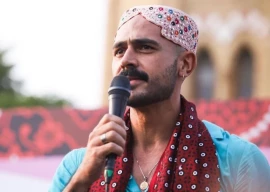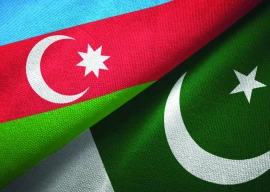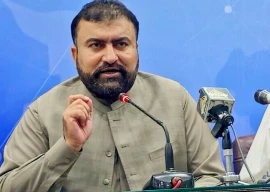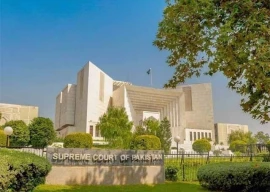
You use a car or motorcycle to get to work and it takes you at least an hour to reach home after 5pm. Imagine being able to save on fuel, time and stress by taking a bus that flows through traffic uninterrupted because it has its own dedicated lane? Oh, and it's air-conditioned and safe and one arrives every two minutes.
This is something called Bus Rapid Transit System (BRTS) and plans are afoot to build it in Karachi for the jugular of MA Jinnah Road, connecting Merewether Tower to as far as University Road.

The ADB-ITDP's proposed design for the Red line merges with 23 existing bus routes that 45,000 people use daily. The blue lines show how they will all feed into the BRT corridor. PHOTO: ITDP
But wait, you say. I prefer my car and I don't use that route anyway. Fair enough. But you still get stuck in traffic a lot because Karachi has too many cars and not enough public transport (only 9,000 buses for 22 million people). Imagine a system that would take the pressure off our roads?
But more than that, think of the future. You live in the world's fastest growing megacity. Experts have estimated that we take 24 million trips a day in the city. Being stuck in traffic is costing us $678 million a year. If we don't do something now, our economy will suffer. Plus, we will just go mad.
The good news is that the Asian Development Bank (ADB) and an experienced transport group, the ITDP, have designed a dedicated bus lane system for MA Jinnah Road. They unveiled it on March 20. The bad news is that the Sindh government doesn't want them to build it.
What is the Red Line?
The ADB asked BRTS experts, the Institute for Transportation and Development Policy (ITDP), to make a plan for Karachi. They have been working since August 2014.
The Red line runs from Safoora roundabout, through University Road, and ends at Merewether Tower. Part of it branches out on Sharae Quaideen past Noorani Kebab House. Another branch goes to Landhi from Nursery on Sharae Faisal.

The ADB and ITDP have planned a Red Line for dedicated bus lanes from Safoora Chowrangi to Merewether Tower, branching out on Shahrah-e-Quaideen, past Nursery, along Shahrah-e-Faisal to go to Landhi. PHOTO: ITDP
"We only have one corridor but we include the existing public bus routes," explained the ITDP's Yoga Adiwinarto to The Express Tribune. "This uses third-generation BRT design." Buses can travel outside the BRT corridor and merge with it. This is how the ADB will fold 23 existing bus routes into the system. These routes include the W-11, Marwat Coach and Gulistan.
Transporters will be helped to acquire the new BRT buses. About 1,500 will be needed. The ITDP counted passengers and found that 45,000 people use these 23 routes daily. Adding BRTS could transport 637,000 people because the buses are not competing or maneuvering against cars and motorcycles in traffic and are stopping at stations.
The Red line will have 38 stations which will be so close that people will only have to walk 250 metres to reach one. The engineers planned them according to where they surveyed people actually stop for buses right now.

The ITDP's cross section of what a BRT line will look like at Safoora.
And all these stations will be on the ground, not elevated, to not only preserve open spaces but also cater to people who find it difficult to climb stairs. Other people's designs are elevated which stand to destroy the beauty of MA Jinnah Road's heritage buildings. "[At some point on MA Jinnah Road, the space] is 19 metres wall to wall," explained Adiwinarto. "We hear that the people who want to build elevated structures will take 14 metres." That leaves just 2.5 metres of space between the elevated structure and the front of the buildings on either side.
The Red line is cheap as it will cost $4 million per km to build compared to a metro, which costs $10 million per kilometre. You can start immediately and it will take a maximum of 24 months. Metro takes a minimum of three years.

The BRT on MA Jinnah road will have stations in red and the spread of the walking access shows in green. Image: ITDP
BRTS is big news these days because several people are racing to be the first to do it. This is a good thing because the city needs mass transit to move the 'masses' who need to get around but hopefully the Sindh Mass Transit Authority will be passed in the next Sindh Assembly session and be staffed by qualified and honest people. A regulator is needed to manage all the different entities who are rushing to make Karachi's BRT. You can't have four different systems made by four different people.
The ADB-ITDP are not the first people to ever design a BRT corridor for Karachi. This has been going on since 1972. What is different this time, though, is that they have fixed a lot of the problems old designs had. It merges with existing bus routes, proposes public transport reform, parking solutions and urban renewal.

This is what BRT looks like in Bogota, Colombia after mayor Enrique Penalosa removed cars. He was nearly impeached for trying. PHOTO: ITDP
And so, even though this is a good plan, which incidentally Karachi urban planner Arif Hasan backs as well, the Sindh government has not decided to use it. "We had a long dialogue with the ADB," said transport secretary Taha Farooqui on March 20. "It offered to build and finance [BRT] but the Sindh government has decided that it will use its own resources and do it through international tendering."
Published in The Express Tribune, March 24th, 2015.


















COMMENTS
Comments are moderated and generally will be posted if they are on-topic and not abusive.
For more information, please see our Comments FAQ